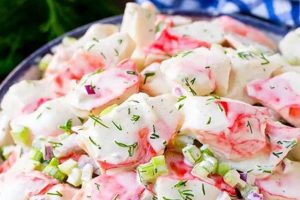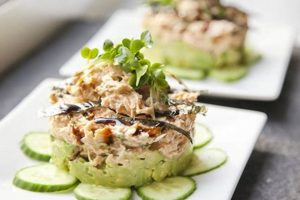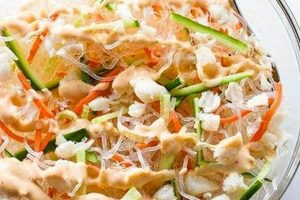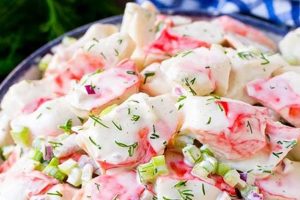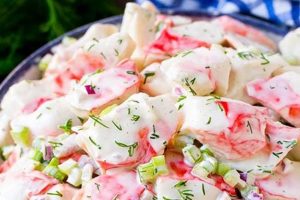A mayonnaise-free crab salad offers a lighter, often healthier, alternative to traditional preparations. It typically features crab meat as the star ingredient, complemented by fresh vegetables, herbs, and a light dressing, often vinaigrette-based. This approach allows the natural sweetness and delicate flavor of the crab to shine through. A simple example might include lump crab meat, celery, red onion, fresh dill, and a lemon vinaigrette.
This style of crab salad appeals to individuals seeking lower-fat options or those with dietary restrictions related to eggs or dairy. Avoiding mayonnaise also extends the salad’s shelf life, making it suitable for picnics or potlucks. Historically, mayonnaise-heavy salads were less common before refrigeration was widespread. Early crab salad recipes often relied on lighter dressings or simply combined crab with other ingredients, highlighting the evolution of culinary practices alongside technological advancements.
Exploring variations on this theme opens up a world of culinary possibilities. Different types of crab, from Dungeness to blue crab, offer unique flavor profiles. Furthermore, the choice of vegetables, herbs, and dressings provides ample opportunity for customization and creativity in the kitchen. This foundation allows for a nuanced discussion of specific ingredients, techniques, and variations in preparing a delicious and healthy mayonnaise-free crab salad.
Tips for Crafting Mayonnaise-Free Crab Salad
Achieving a flavorful and satisfying crab salad without mayonnaise requires attention to detail and careful selection of ingredients. The following tips offer guidance for creating a successful dish.
Tip 1: Prioritize Fresh, High-Quality Crab Meat: The crab meat forms the foundation of the salad. Opting for fresh, high-quality crab, whether lump, claw, or backfin, ensures optimal flavor and texture. Canned crab can be used, but it should be thoroughly drained and flaked.
Tip 2: Balance Moisture Content: Excess moisture can dilute the flavor and create a watery salad. Vegetables with high water content, like cucumbers or tomatoes, should be used sparingly or seeded and drained thoroughly.
Tip 3: Enhance Flavor with Fresh Herbs: Fresh herbs contribute brightness and complexity. Dill, parsley, chives, and tarragon are excellent choices, complementing the delicate flavor of the crab.
Tip 4: Explore Citrus and Vinaigrettes: A vibrant citrus vinaigrette adds a zesty counterpoint to the richness of the crab. Lemon, lime, or grapefruit juice can be combined with olive oil, herbs, and seasonings for a light and refreshing dressing.
Tip 5: Consider Textural Variety: Incorporating ingredients with contrasting textures elevates the salad. Finely diced celery or bell peppers offer crispness, while avocado adds creaminess.
Tip 6: Season Judiciously: Salt and freshly ground black pepper are essential, but other seasonings can enhance the flavor profile. A pinch of cayenne pepper adds a subtle heat, while Old Bay seasoning provides a classic seafood flavor.
Tip 7: Chill Thoroughly Before Serving: Allowing the salad to chill in the refrigerator for at least 30 minutes allows the flavors to meld and enhances the overall experience.
By following these guidelines, one can create a delicious and satisfying crab salad that highlights the natural sweetness of the crab without relying on mayonnaise.
These tips provide a starting point for exploration and customization. Experimentation with different ingredients and flavor combinations will lead to the discovery of personalized preferences and variations.
1. Fresh, High-Quality Crab
Fresh, high-quality crab meat is paramount in mayonnaise-free crab salad recipes. The absence of mayonnaise, which typically masks subpar ingredients with its richness, places the crab’s flavor profile at the forefront. Any off-notes or lack of freshness become immediately apparent. Using superior crab meat ensures the salad’s success, delivering a clean, sweet, and delicate flavor experience. For example, freshly cooked and picked Dungeness crab, known for its sweet and succulent meat, elevates a simple salad with minimal additional ingredients. Conversely, using canned crab, while acceptable, requires more assertive seasonings and additions to compensate for the potential lack of freshness.
The type of crab also influences the final product. Lump crab meat, prized for its large, intact pieces, provides a luxurious texture and delicate flavor, ideal for showcasing in a simple salad with a light vinaigrette. Claw meat, while smaller and more fragmented, offers a more intense crab flavor. Backfin, a combination of smaller pieces, works well in salads with bolder flavors and textures. Understanding these nuances allows for strategic ingredient selection to achieve specific flavor and texture goals. Freshly picked crab, locally sourced when possible, generally offers the best quality and reduces the risk of encountering inferior product. Proper storage, keeping the crab chilled until immediately before use, further preserves its quality and contributes to the final dish’s success.
In conclusion, prioritizing fresh, high-quality crab meat is non-negotiable for achieving a truly exceptional mayonnaise-free crab salad. This foundational ingredient dictates the overall flavor and textural experience. Careful selection and proper handling are crucial for maximizing the delicate sweetness and showcasing the true potential of this versatile seafood in a lighter, healthier preparation.
2. Light, Flavorful Dressing
Light, flavorful dressings are essential to a successful mayonnaise-free crab salad. The omission of mayonnaise, a rich and heavy emulsified sauce, necessitates a dressing that provides flavor and moisture without overwhelming the delicate crab. Such dressings enhance the natural sweetness of the crab while contributing textural and aromatic complexity. A heavy dressing would mask the subtle crab flavor, while a bland dressing would result in a lackluster salad. The dressing acts as a unifying element, binding the other ingredients together while providing a counterpoint to the richness of the crab.
Vinaigrettes, with their inherent lightness and versatility, prove particularly well-suited for this application. A simple lemon vinaigrette, composed of fresh lemon juice, olive oil, salt, and pepper, offers a bright, acidic counterpoint to the sweetness of the crab. Variations incorporating Dijon mustard add a touch of tanginess, while those with minced shallots or herbs provide aromatic depth. A vinaigrette made with high-quality extra virgin olive oil contributes fruity notes and a luxurious mouthfeel, complementing the delicate texture of the crab. Furthermore, the acidity in vinaigrettes helps to preserve the freshness of the crab salad, extending its shelf life compared to mayonnaise-based versions. For example, a grapefruit and tarragon vinaigrette adds a refreshing citrusy complexity to a crab salad featuring avocado and red onion, while a champagne vinaigrette with chives complements a classic preparation with celery and dill.
Ultimately, the choice of dressing significantly impacts the overall sensory experience of a mayonnaise-free crab salad. It provides an opportunity to enhance and elevate the natural flavors of the crab, creating a dish that is both refreshing and satisfying. Careful consideration of flavor profiles, acidity levels, and complementary ingredients ensures a harmonious balance and a truly delicious culinary outcome. The success of a mayonnaise-free crab salad often hinges on this careful balance, demonstrating the importance of understanding the role and potential of light, flavorful dressings in this context.
3. Crisp, Complementary Vegetables
Crisp, complementary vegetables play a crucial role in mayonnaise-free crab salad recipes. Their textural contrast and distinct flavors enhance the overall sensory experience, balancing the richness of the crab and the lightness of the dressing. Careful selection of these vegetables prevents the salad from becoming monotonous and adds depth of flavor.
- Textural Contrast
The inherent softness of crab meat benefits from the addition of crisp vegetables. Celery, finely diced, offers a satisfying crunch, while thinly sliced fennel provides a delicate anise flavor and a refreshing bite. This contrast prevents the salad from becoming overly soft or mushy, creating a more dynamic and enjoyable mouthfeel.
- Flavor Enhancement
Vegetables contribute distinct flavor profiles that complement the sweetness of the crab. Red onion adds a subtle sharpness, while bell peppers introduce a mild sweetness and vibrant color. Jalapeos, used sparingly, offer a touch of heat. The chosen vegetables should enhance, not overpower, the delicate crab flavor.
- Visual Appeal
Vibrant vegetables enhance the salad’s visual appeal. The inclusion of colorful bell peppers, finely chopped red onion, or bright green celery creates an aesthetically pleasing presentation. Visual appeal stimulates appetite and elevates the dining experience.
- Nutritional Value
Incorporating a variety of vegetables increases the nutritional value of the crab salad. Vegetables provide essential vitamins, minerals, and fiber, contributing to a healthier and more balanced meal. This aspect aligns with the generally lighter and healthier profile of mayonnaise-free crab salad.
The strategic inclusion of crisp, complementary vegetables elevates mayonnaise-free crab salad from a simple dish to a more complex and satisfying culinary experience. Their contribution extends beyond mere texture and flavor, enhancing visual appeal and nutritional value. The careful selection and balance of these ingredients ensure a harmonious and delicious final product.
4. Aromatic Fresh Herbs
Aromatic fresh herbs contribute significantly to the flavor profile of mayonnaise-free crab salad. Their inclusion elevates the dish beyond simple ingredients, adding layers of complexity and freshness. Understanding the role of these herbs allows for strategic selection and optimal flavor pairings.
- Balancing Delicacy and Brightness
Fresh herbs provide a counterpoint to the richness of the crab while enhancing its inherent sweetness. Dill, with its slightly anise-like flavor, complements the delicate nature of the crab without overpowering it. Parsley adds a clean, fresh element, while chives contribute a subtle oniony note. The goal is to enhance, not mask, the crab’s flavor.
- Creating Flavor Synergies
Specific herb choices can create synergistic relationships with other salad components. Tarragon, with its subtle licorice notes, pairs well with a Dijon vinaigrette. Mint, used sparingly, adds a refreshing burst alongside citrus elements. These combinations create a more complex and nuanced flavor profile.
- Enhancing Visual Appeal
Beyond flavor, fresh herbs contribute to the salad’s visual appeal. The vibrant green of dill, parsley, or chives provides a pop of color against the backdrop of the crab and other ingredients. This visual element enhances the overall dining experience.
- Adding Nutritional Value
Fresh herbs offer nutritional benefits, aligning with the healthier profile of mayonnaise-free crab salad. They contain vitamins, minerals, and antioxidants, adding another layer of value to the dish.
The strategic use of aromatic fresh herbs elevates mayonnaise-free crab salad from a simple combination of ingredients to a more sophisticated and flavorful culinary creation. Their contribution goes beyond mere flavor enhancement, encompassing visual appeal, nutritional value, and the creation of complex flavor synergies. This careful consideration of herbs underscores their importance in achieving a truly exceptional and balanced dish.
5. Balanced Seasoning
Balanced seasoning is crucial in mayonnaise-free crab salad recipes. The absence of mayonnaise, which often contributes a significant amount of salt and tang, necessitates a more nuanced approach to seasoning. Careful attention must be paid to salt levels, acidity, and the interplay of other spices to achieve a harmonious flavor profile. Over-seasoning can easily overwhelm the delicate crab flavor, while under-seasoning results in a bland and unappetizing dish. The goal is to enhance the natural sweetness of the crab and the other ingredients without masking their individual characteristics. For instance, a crab salad featuring a lemon vinaigrette might benefit from a pinch of black pepper and a touch of cayenne for subtle heat, while a salad with a Dijon vinaigrette might be complemented by dried tarragon and a hint of onion powder. The interplay of these seasonings creates a more complex and satisfying flavor experience.
The type of salt used also influences the final outcome. Fine sea salt dissolves readily and distributes evenly, ensuring consistent seasoning. Flaky sea salt, used as a finishing touch, adds a pleasant textural element and a burst of salinity. Beyond salt and pepper, other spices can add depth and complexity. Old Bay seasoning, a blend of celery salt, paprika, and other spices, complements seafood beautifully. A pinch of smoked paprika can introduce a subtle smoky note, while a dash of celery seed enhances the natural celery flavor often present in crab salad. However, restraint is key. The goal is to create a balanced flavor profile where no single spice dominates, allowing the delicate crab flavor to shine through.
Achieving balanced seasoning requires careful tasting and adjustment throughout the preparation process. Initial seasoning of the crab meat itself ensures that the flavor is infused throughout. Further adjustments to the vinaigrette and the final salad ensure a harmonious balance. This iterative process allows for precise control over the final flavor profile, resulting in a crab salad that is both flavorful and nuanced. Mastering this aspect of preparation elevates the dish from simple to sophisticated, showcasing the potential of a mayonnaise-free approach.
6. Proper Chilling
Proper chilling is essential for food safety and optimal flavor development in mayonnaise-free crab salad. Unlike traditional crab salad stabilized by mayonnaise’s emulsified structure, mayonnaise-free versions rely on the delicate interplay of individual ingredient flavors. Chilling allows these flavors to meld and harmonize, creating a more cohesive and enjoyable sensory experience. Furthermore, proper chilling inhibits bacterial growth, ensuring food safety, particularly crucial given the perishable nature of seafood.
- Food Safety
Chilling at appropriate temperatures significantly reduces the risk of bacterial growth. Harmful bacteria, such as Vibrio parahaemolyticus, sometimes found in raw seafood, multiply rapidly at room temperature. Maintaining a temperature below 40F (4C) inhibits this growth, safeguarding against foodborne illnesses. This is particularly critical for mayonnaise-free crab salad, as it lacks the protective barrier of mayonnaises acidity.
- Flavor Enhancement
Chilling allows the flavors of individual ingredients to meld and harmonize. The volatile aromatic compounds in fresh herbs and vegetables integrate with the delicate flavor of the crab meat, creating a more complex and balanced flavor profile. This integration is enhanced during the chilling process, resulting in a more cohesive and enjoyable culinary experience.
- Texture Improvement
Chilling enhances the textural appeal of the salad. Crisp vegetables retain their texture, while the crab meat firms slightly, improving the overall mouthfeel. A well-chilled salad offers a refreshing and satisfying contrast in textures, further elevating the dining experience.
- Extended Shelf Life
While mayonnaise-free crab salad generally has a shorter shelf life than its mayonnaise-based counterpart, proper chilling maximizes its longevity. Lower temperatures slow down enzymatic processes that contribute to spoilage, allowing the salad to remain fresh and flavorful for a longer period. This is particularly important for preparing the salad in advance for events or gatherings.
In conclusion, proper chilling is a critical step in preparing mayonnaise-free crab salad, contributing significantly to food safety, flavor enhancement, textural improvement, and extended shelf life. These factors, working in concert, elevate the dish beyond a simple combination of ingredients, ensuring a safe, flavorful, and enjoyable culinary experience.
Frequently Asked Questions
This section addresses common inquiries regarding the preparation and enjoyment of crab salad without mayonnaise.
Question 1: What are the advantages of omitting mayonnaise?
Omitting mayonnaise reduces the overall fat content, caters to egg and dairy allergies, allows the crab flavor to shine, and extends shelf life compared to traditional mayonnaise-based versions. This approach also aligns with lighter, healthier eating preferences.
Question 2: What type of crab meat is most suitable?
Fresh lump crab meat offers the best flavor and texture. Fresh claw meat or backfin provide more intense crab flavor but may have a less refined texture. Canned crab meat can be used but should be drained thoroughly and may require more assertive seasoning.
Question 3: What dressings can replace mayonnaise?
Light vinaigrettes, often citrus-based, are ideal. Lemon, lime, or grapefruit juice combined with olive oil, herbs, and seasonings create a refreshing and flavorful dressing. Greek yogurt can also provide a creamy texture with less fat than mayonnaise, but alters the flavor profile.
Question 4: How can moisture content be managed effectively?
Select vegetables with lower water content or remove excess moisture from watery vegetables. Thoroughly drain canned crab meat. Avoid overdressing the salad. These steps prevent a watery final product.
Question 5: How long can mayonnaise-free crab salad be stored?
Properly stored in an airtight container in the refrigerator, mayonnaise-free crab salad typically lasts for 2-3 days. Consume within this timeframe for optimal flavor and food safety. Storage times may vary based on ingredient freshness and storage conditions.
Question 6: Can this salad be frozen?
Freezing is not recommended. Freezing negatively impacts the texture of the crab meat and vegetables, resulting in a watery and less appealing salad upon thawing. It’s best to prepare and consume the salad fresh.
Understanding these aspects allows for informed choices in crafting and enjoying a delicious and healthy mayonnaise-free crab salad.
The following section offers specific recipe variations to further explore the versatility of this dish.
Conclusion
Exploration of mayonnaise-free crab salad recipes reveals a focus on fresh, high-quality ingredients and balanced flavor profiles. Prioritizing fresh crab meat, utilizing light and flavorful dressings like vinaigrettes, incorporating crisp vegetables and aromatic herbs, and achieving balanced seasoning are crucial for success. Proper chilling techniques ensure both food safety and optimal flavor development. The omission of mayonnaise allows the natural sweetness and delicate texture of the crab to shine, offering a lighter and often healthier alternative to traditional preparations. Understanding these elements empowers culinary exploration and customization.
Mayonnaise-free crab salad represents a shift towards lighter, brighter flavors and an emphasis on ingredient quality. This approach encourages culinary creativity and allows for personalized variations based on individual preferences and dietary considerations. Continued exploration of ingredient combinations and flavor profiles promises further evolution and refinement within this culinary niche. The potential for innovation within this seemingly simple dish remains vast, offering a canvas for both home cooks and culinary professionals to explore the nuances of flavor and texture.

